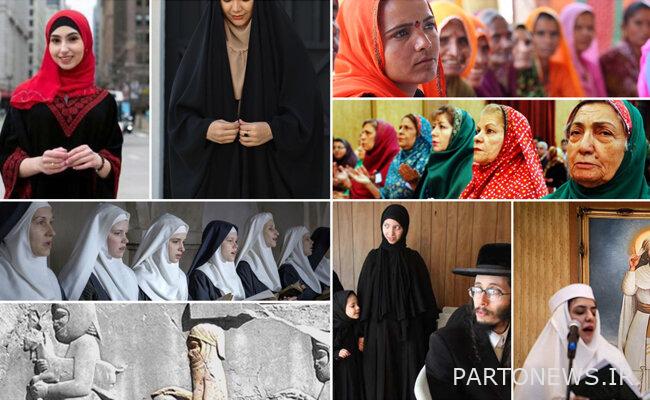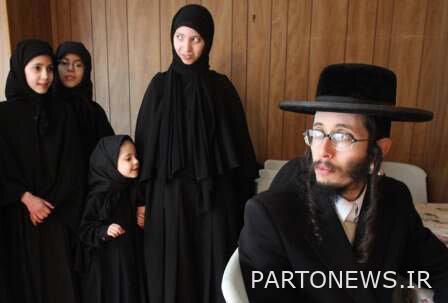There is no nudity in the teachings of any of the non-monotheistic religions – Mehr news agency Iran and world’s news

Mehr News Agency – Department of Religion and Thought – Fatemeh Aliabadi: Since the beginning of creation, man has been trying to cover his body in different ways, which shows the naturalness of chastity and covering. Iranian women have always had veil and hijab in their mythological history and considered it as one of their duties. Ferdowsi’s Shahnameh, as one of the most original documentary sources of Iranian history, provides signs of veiling and hijab for women.
In general, in all cases where women are mentioned in the Shahnameh, it is about their modesty, authenticity, purity, truth and the perfect example of their femininity. As long as the women of Shahnameh take this path, they are considered and consecrated by Hakim Tous and the Iranian society, if not hated and rejected. In the Shahnameh, a good and pure woman is sanctified, and a bad, shameless, shameless, and impertinent woman is condemned.
The culture of ancient Iranians was formed based on the teachings of Zoroastrian religion. This ritual also emphasizes principles such as truth and correctness, avoiding lies, consolidating the foundations of the family, and raising pure children. Therefore, the necessity of women’s clothing in Zoroastrian religion and ancient Iranian culture has been considered and recommended.
Hijab means “covering a woman’s body in front of the non-mahram” is one of the essential rules of Islam, in other divine religions such as Zoroastrianism, Judaism and Christianity, this rule exists with more or less differences.
Accordingly, for the analysis of hijab and chastity in monotheistic religions Hojjat al-Islam, Dr. Mohammad Hossein Taheri Akerdi The author and member of the faculty of Religions Department of Imam Khomeini Educational and Research Institute “Ra” had a conversation, the result of which you can read below:
* How is the philosophy of hijab expressed in divine religions and what is its history in these religions?
Hijab is an output and a sign of chastity that prevails in every society. If chastity is a value in a society, hijab is a behavior that introduces that norm and value with tools. The divisions that have existed throughout history for different religions are divided into early religions, eastern religions, monotheistic religions and Abrahamic religions. What has existed in Western thought since the past and has its roots in ancient Greece and Rome is that there was some nudity among Westerners, which can be seen in the statues left from that time. But aside from this amount of nudity that has existed in Western thought, almost all religions of the world, both monotheistic and non-monotheistic, have the issue of chastity and, as a result, the hijab.

* Please cite as an example.
Looking at various religions such as Hinduism and Buddhism and their similar religions, which are not monotheistic religions and fall under the category of Eastern religions, nudity is not observed in any of them. The clothing of old Japanese women and their traditional clothes called kimono are completely long and covered, the clothes of Chinese and Korean women are similar to kimono and even longer. In these cultures, those women who were richer wore their clothes longer so that they were stretched on the ground and not even their steps could be seen. Indian women’s dress called saree was also a very worn dress; Sari is actually a five to six meter cloth that Indian women wrap around themselves and even put a part of it on their head. Therefore, even Buddhist and Hindu men and women wore clothes in the past.
Was the issue of covering only for women in the past?
no
In the past, the issue of covering was not only for women, but also for men
* How was men’s clothing in different cultures at that time?
In different cultures, men usually wore a hat appropriate to their culture and wore long clothes.
* What was the main reason for the spread of the culture of wearing clothes in the East?
The main reason for this wearing is to pay attention to the principle of chastity and modesty in Eastern culture.
The clothing of old Japanese women and their traditional clothes called kimono are completely long and covered, the clothes of Chinese and Korean women are similar to kimono and even longer. In these cultures, those women who were more wealthy wore clothes longer so that they were stretched on the ground and not even their steps could be seen.
*How is hijab defined in monotheistic religions and how important was Zoroastrianism to the issue of hijab?
In the division of monotheistic religions, Zoroastrianism is placed next to Judaism, Christianity and Islam. According to the evidence of history, in all monotheistic religions, the category of chastity and modesty and, accordingly, hijab exist as a principle. Zoroastrianism is a religion that was common in ancient Iran, with a little precision in the stone inscriptions left from the Achaemenid period, it is clear that very few cases of female statues are seen, even in them, the face of a woman cannot be seen well, and only women’s eyes. It can be seen, the reason is that the women’s clothing of this era was a whole cloth and a niqab.
*According to the stated content, since when did Iranian women turn to full hijab?
The tent has been in the ancient Iranian culture since the Achaemenid, Parthian and even Sassanian eras and has continued since then. Basically, chador is an Iranian hijab and has nothing to do with Islam. A thousand years before Islam, Iranian women used chador. Even Iranians usually used coffins in funerals. In the Arabian Peninsula and Hijaz, coffins were not used and still are not.
In many Arab countries, two sticks were connected by a cloth and the corpse was placed on it. In some historical reports, it is mentioned that Mr. Salman Farsi suggested to Amirul Momineen (AS) to build a coffin for the pure body of Hazrat Zahra (S) so that her pure body would not be found. This shows that Iranians paid a lot of attention and care to the category of chastity and hijab.
* How has the issue of hijab been in other monotheistic religions such as Judaism and Christianity?
The issue of hijab is also very prominent in other religions. In the oldest monotheistic religion, which is Judaism, like Christianity and Islam, women must be covered and they are only allowed not to cover the face and hands up to the wrists. Although in the contemporary era, the Jewish reformers and conservatives under the influence of Western culture do not wear a full hijab, but if they see orthodox women, they may be thought to be Muslims. It is interesting that in Judaism women do not even have the right to show their hair to their brothers and fathers after marriage. Orthodox Jewish women usually find it very bad to wear pants and only use long, loose veils and niqabs to cover themselves so that only their eyes are visible.

* How has it been in Christianity?
Full hijab is also mentioned in Christianity. Christians today, like Jews in Europe and America, lost many of their principles under the influence of liberalism culture, but with a little care, we can understand that there is still a hijab in the Christian era, and women wear veils and long mantles, and men wear long dresses. The same issue exists in Islam, in fact, the circle of hijab in Islam is a little easier than it was in Judaism and Christianity.
*Which covering is introduced as correct covering in Islam?
The veil that is introduced as the correct veil in Islam is actually a confirmation of what was there in the past. Many of the rulings of Islam are not established, but confirmed, such as prayer, zakat, and fasting, which exist in all religions. Allah Almighty says about Zakat in the Qur’an: “And give Zakat” and does not give an explanation, or He says: “Kitab Alaikum al-Saam kama Kitab Ali Al-Dhin min Qiblakum”, fasting has become obligatory for you as it was obligatory for those before you. has been The issue of hijab is also one of the confirmation issues of Islam, a category that has existed in other religions and has been confirmed by Islam. Today, some people think that hijab is only for Muslim women, they are completely wrong.
The chador has been in ancient Iranian culture since the Achaemenid, Parthian and even Sasanian eras, and has continued since then, Iranian women used chador for a thousand years before Islam.
*Therefore, throughout history, Iranian women’s veil and hijab have been much more covered than what is required by Islam.
Exactly right.
Therefore, we should say to those who are shouting slogans of nationalism these days, calling for freedom from Iran and opposing the hijab, if you don’t want to be Iranian, then you should choose the clothes you wear like the Achaemenids. Being Iranian means to choose historical Iranian clothes, not to wear completely western clothes and say that we must be Iranian.
* Since when did the culture of hijab and chastity change in the world? And what was the reason for this change?
Unfortunately, a large part of the world’s people were influenced by Western culture from the second half of the 20th century onwards, because the Westerners had money and media, and by using art, cinema and media, they placed their culture in the world.
Today, many women from Korea, Japan, China, India, Iran and many other countries have abandoned their historical traditional clothes and use western clothes and symbols. For this reason, the hijab debate is more of a national debate than a religious one. Clothing is a part of the culture and civilization of any country, if you want to destroy the civilization of a civilized country and bring it under your cultural domination, you must destroy its cultural symbols. Architecture, food, clothes and clothing are among the cultural symbols of a civilization. This is the reason why today many of our architectures are oriented towards western architecture and most of the houses are like western houses. Open built and also apartment living in cities has increased, these are all symbols of western culture, Iran’s past was not like this and Iran is a country that has advanced architecture for itself and has created natural heating and cooling systems in houses.
Those who want to be Iranian should see how Iranians used to wear clothes in the past and to what extent they observed hijab and chastity. They should behave in the same Iranian way. It is not necessary to follow the instructions of Islam, just being Iranian is enough. Hijab has been intertwined with the nature of Iranians throughout history and their ancient past, and later with the advent of Islam, it was also approved by Islam.
Every Iranian must protect his authenticity and not be deceived by the enemies’ game. The liberal capitalist thinking wants to bring all the people of the world into their culture, to dress the same and eat the same food, and generally to be subject to the western culture in all aspects of life. In the past, we had all kinds of food, and Iranian mothers had created a high variety of food for their families, but today, the eating style of many people, like Westerners, is to use fast food.
* Some say that the freedom to choose clothing is a right that has been denied to Iranian women for years; How true is this statement?
Freedom is a concept that is mentioned a lot in recent events, but in practice it is presented completely against it, those who breathe freedom today do not know culture and history. Education and higher education had the duty to teach teenagers and young people the true meaning of these concepts. It is a big flaw that national heroes are not introduced to students in textbooks and national history, identity and civilization are not introduced to them. If these contents and concepts are explained to teenagers and young people, they will no longer be deceived by foreign media. But if there is no mention of national identity and civilization, students and young people will search for their identity in cyber space. A virtual space that is managed by the enemies and they manage it based on their culture and goals. This is why today, unfortunately, dog walking, the presence of a dog in the family instead of a child, and removing siblings due to the existence of a dog has entered the lifestyle of some families.
In Iran, the life of a university is less than a hundred years, but the life of medicine, engineering and architecture is several centuries. All these sciences grew out of the theological fields, which, in addition to religious issues, also dealt with architectural, cultural, medical, nutrition, and clothing issues. Unfortunately, we fell short in these areas.
* Some people question and criticize whether they treated the veil like this in the beginning of Islam. What is the answer to this question and criticism?
Those who question and criticize like this, it is clear that these people did not study history at all, the answer should be said, was there no hijab at all during the time of Amir al-Mominin (AS) and the Holy Prophet (S)? At that time, there was no hijab even in the East of the world. Not wearing hijab was for slaves, poor and lonely people, and all people with character and descent wore hijab. In addition, the Prophet (pbuh), Amirul Momineen (pbuh) and all Imams of Athar (pbuh) always emphasized on the issue of chastity and zeal. Amir al-Mu’minin (A.S.) forbids men who are not jealous and says: I am surprised by men who go to crowded markets with their wives and their women’s trunks rub against men’s trunks.
Hazrat Zahra (PBUH) says: A woman’s happiness is that a man does not see her and she does not see a man. The meaning of Hazrat Zahra’s enlightened words is not that women should stay at home, but this word refers to the importance of chastity and hijab, because hijab is basically a social principle and not an individual one. A woman is not required to wear hijab at home. Hazrat Zahra’s speech can be interpreted as saying that we should have a hospital where the head of the hospital, staff, doctors and nurses are all women, and the university and other facilities that women need should be like this.

